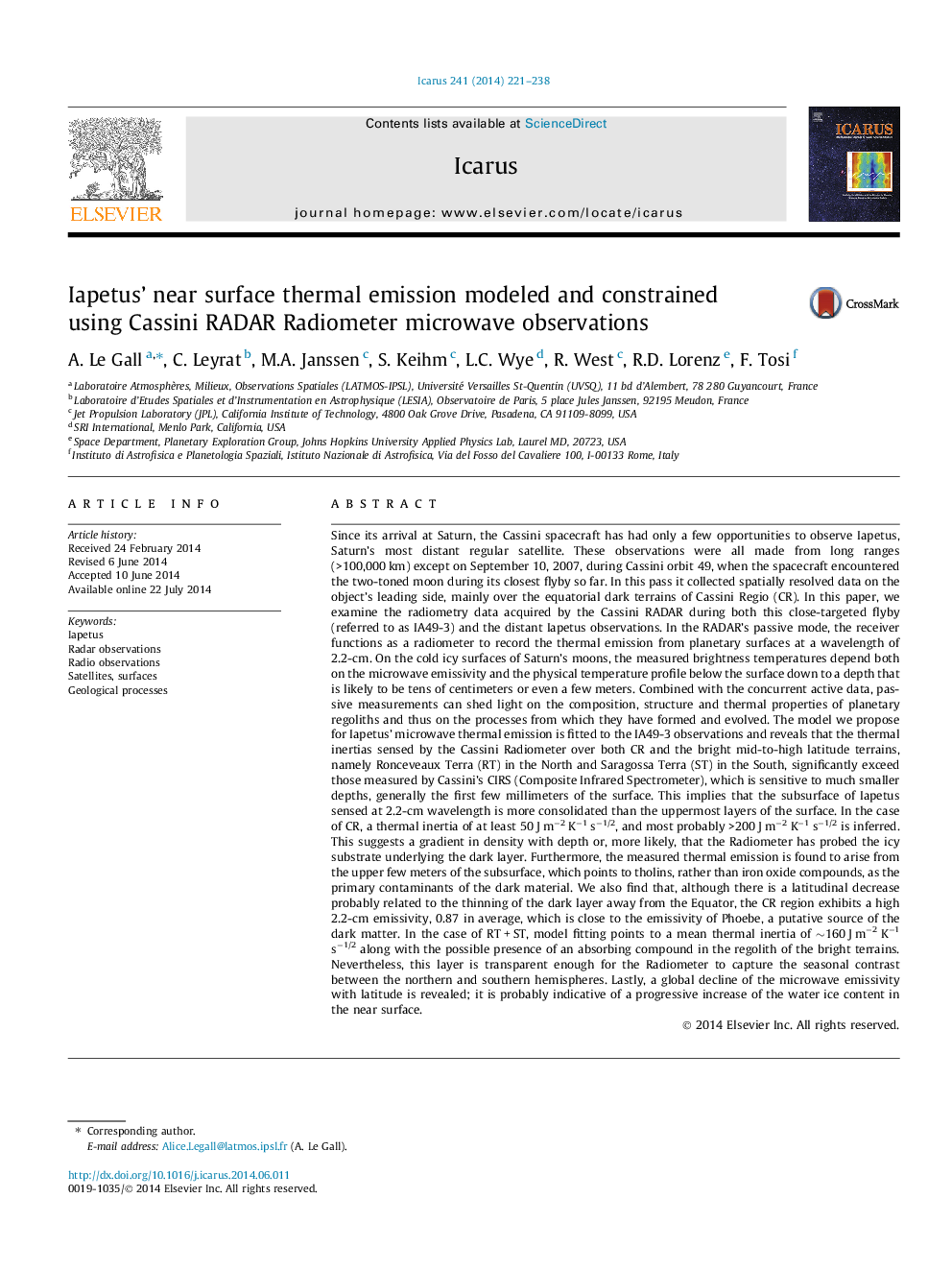| کد مقاله | کد نشریه | سال انتشار | مقاله انگلیسی | نسخه تمام متن |
|---|---|---|---|---|
| 8137789 | 1523549 | 2014 | 18 صفحه PDF | دانلود رایگان |
عنوان انگلیسی مقاله ISI
Iapetus' near surface thermal emission modeled and constrained using Cassini RADAR Radiometer microwave observations
ترجمه فارسی عنوان
انتشار حرارتی نزدیک یاتیکس با استفاده از مشاهدات مایکروویو رادیوم کاسینی رادار، مدلسازی شده و محدود شده است
دانلود مقاله + سفارش ترجمه
دانلود مقاله ISI انگلیسی
رایگان برای ایرانیان
کلمات کلیدی
موضوعات مرتبط
مهندسی و علوم پایه
علوم زمین و سیارات
علوم فضا و نجوم
چکیده انگلیسی
Since its arrival at Saturn, the Cassini spacecraft has had only a few opportunities to observe Iapetus, Saturn's most distant regular satellite. These observations were all made from long ranges (>100,000Â km) except on September 10, 2007, during Cassini orbit 49, when the spacecraft encountered the two-toned moon during its closest flyby so far. In this pass it collected spatially resolved data on the object's leading side, mainly over the equatorial dark terrains of Cassini Regio (CR). In this paper, we examine the radiometry data acquired by the Cassini RADAR during both this close-targeted flyby (referred to as IA49-3) and the distant Iapetus observations. In the RADAR's passive mode, the receiver functions as a radiometer to record the thermal emission from planetary surfaces at a wavelength of 2.2-cm. On the cold icy surfaces of Saturn's moons, the measured brightness temperatures depend both on the microwave emissivity and the physical temperature profile below the surface down to a depth that is likely to be tens of centimeters or even a few meters. Combined with the concurrent active data, passive measurements can shed light on the composition, structure and thermal properties of planetary regoliths and thus on the processes from which they have formed and evolved. The model we propose for Iapetus' microwave thermal emission is fitted to the IA49-3 observations and reveals that the thermal inertias sensed by the Cassini Radiometer over both CR and the bright mid-to-high latitude terrains, namely Ronceveaux Terra (RT) in the North and Saragossa Terra (ST) in the South, significantly exceed those measured by Cassini's CIRS (Composite Infrared Spectrometer), which is sensitive to much smaller depths, generally the first few millimeters of the surface. This implies that the subsurface of Iapetus sensed at 2.2-cm wavelength is more consolidated than the uppermost layers of the surface. In the case of CR, a thermal inertia of at least 50Â JÂ mâ2Â Kâ1Â sâ1/2, and most probably >200Â JÂ mâ2Â Kâ1Â sâ1/2 is inferred. This suggests a gradient in density with depth or, more likely, that the Radiometer has probed the icy substrate underlying the dark layer. Furthermore, the measured thermal emission is found to arise from the upper few meters of the subsurface, which points to tholins, rather than iron oxide compounds, as the primary contaminants of the dark material. We also find that, although there is a latitudinal decrease probably related to the thinning of the dark layer away from the Equator, the CR region exhibits a high 2.2-cm emissivity, 0.87 in average, which is close to the emissivity of Phoebe, a putative source of the dark matter. In the case of RTÂ +Â ST, model fitting points to a mean thermal inertia of â¼160Â JÂ mâ2Â Kâ1Â sâ1/2 along with the possible presence of an absorbing compound in the regolith of the bright terrains. Nevertheless, this layer is transparent enough for the Radiometer to capture the seasonal contrast between the northern and southern hemispheres. Lastly, a global decline of the microwave emissivity with latitude is revealed; it is probably indicative of a progressive increase of the water ice content in the near surface.
ناشر
Database: Elsevier - ScienceDirect (ساینس دایرکت)
Journal: Icarus - Volume 241, October 2014, Pages 221-238
Journal: Icarus - Volume 241, October 2014, Pages 221-238
نویسندگان
A. Le Gall, C. Leyrat, M.A. Janssen, S. Keihm, L.C. Wye, R. West, R.D. Lorenz, F. Tosi,
